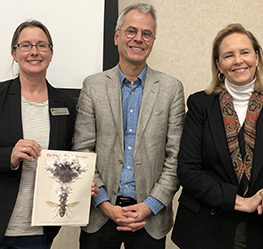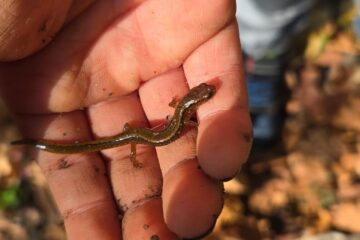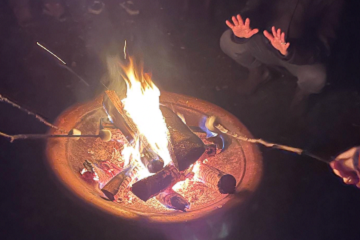
Dr. Kristi MacDonald, Dr. Hans de Kroon, Cindy Ehrenclou at Nov. 23 “Insect Armageddon” talk.
There is an “Insect Armageddon” going on in many parts of the world, but changes in human behavior can reverse this alarming trend for the insects that pollinate plants and feed songbirds.
“There’s no reason to panic. If you do the right things, you can get them back,” Dr. Hans de Kroon told a crowd of 130 people at Raritan Valley Community College on Saturday, Nov. 23. The time to act is now, he said.
A lead researcher in a 2017 study documenting dramatic insect declines, Dr. de Kroon said some of the keys to helping insects recover is stopping harmful pesticide use and planting native wildflowers to provide food for insects. He noted that 80 percent of all plants, including many agricultural crops, rely on insects for pollination, and that insects are an integral part of the food web for birds and other animals.
Dr. de Kroon’s talk was sponsored by the college and the nonprofit conservation group Raritan Headwaters Association (RHA).
“Insects are the canaries in the coal mine,” said Dr. Kristi MacDonald, director of science for Raritan Headwaters, who introduced Dr. de Kroon. “When they’re not present in abundance, we know the ecosystem is not functioning properly.”
Cindy Ehrenclou, executive director of Raritan Headwaters, urged local residents to take action to help insects and the entire food web.
“We can all play a part in helping insect populations rebound by supporting organic agriculture, planting native flowering plants in our gardens and decreasing use of pesticides and fertilizers,” she said. “Insect pollinators are essential to our food supply – we can’t live without them.”
Study of German Nature Reserves
Dr. de Kroon, a professor of plant ecology at Radboud University in the Netherlands, was part of the research team which discovered that three-quarters of the flying insects at nature preserves in Germany had disappeared between 1989 and 2017.
The research was based on a trove of data collected by a German entomological society at 63 nature reserves. For 27 years, society members collected flying insects in special traps and then weighed their total “biomass.” The same geographic locations and trap designs were used each year.
The entomological society asked Dr. de Kroon to help analyze the data after learning of a study he co-authored correlating neonicotinoid pesticide use with bird decline in the Netherlands.
Dr. de Kroon and his fellow researchers found that flying insect numbers had plunged by an average of 76 percent since 1989. And in the middle of summer, when insect numbers usually peak, the decline was even more severe at 82 percent.
A disturbing aspect of the study was that declines were not limited to rare or sensitive species, but were seen in all insects from beetles to butterflies and included losses of even the most common species.
Dr. de Kroon said researchers were puzzled about the cause of the decline, since land use surrounding the preserve hadn’t changed significantly during the data collection period. They theorized that pesticide spray from nearby farms had gotten into the ecosystems. “Even at small concentrations, they can disrupt insect life,” he said.
Other potential causes, he said, are nitrogen from fertilizers getting into the soil and agricultural techniques that don’t allow for hedgerows and native wildflowers. Farms without native plants, he said, are an “ecological trap” for insects because they look attractive but don’t offer food that they can eat. The same is likely true of urban and suburban landscapes where many lawns and gardens lack native plants and pesticides are heavily applied.
The study drew the conclusion that the insect decline trend could potentially be applied to all areas of the world where human disturbance is high.
“As far as we can see, it (the insect decline) is a worldwide phenomenon,” Dr. de Kroon said. “There’s not a single cause, which means there’s probably not a single solution,” Dr. de Kroon said.
Since the German insect decline study made headlines around the world, he said, a movement to save the insects has sprung up in Europe. That movement resulted in a ban throughout the European Union on neonicotinoid pesticide spraying in open fields, and an effort to bring back hedgerows and native wildflower strips in agricultural areas.
So far, said Dr. de Kroon, it seems to be working. In one small flower-rich area near his city in Holland, researchers found nearly 1,000 bees from 78 wild bee species. “It’s nice to know that we can do something, really,” he said.
Saving the insects, he added, means saving the birds that rely on them for food. “Keeping the common species common is our goal,” he said.
Dr. de Kroon said he would like to see more insect studies conducted around the world. He cautioned that studies – for example, those investigating the safety of pesticides – should not rely on lab results alone but should be based on data from the field: “Lab studies do not reflect what we see in nature.”
About Raritan Headwaters
Raritan Headwaters Association (RHA), based in Bedminster, has been working since 1959 to protect, preserve and improve water quality and other natural resources of the Raritan River headwaters region through efforts in science, education, advocacy, land preservation and stewardship.
RHA’s 470-square-mile region provides clean drinking water to 300,000 residents of 38 municipalities in Somerset, Hunterdon and Morris counties and beyond to some 1.5 million homes and businesses in New Jersey’s densely populated urban areas.
To learn more about Raritan Headwaters, please visit www.raritanheadwaters.org or call 908-234-1852.



